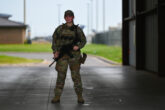March 19, 2022
Military Food Insecurity- What is Going On?
Last November, Secretary of Defense Lloyd Austin spoke at a press conference highlighting Pentagon actions to alleviate financial pressures on military service members and their families throughout the COVID-19 pandemic. He spoke about the hardships faced by military families, including food insecurity. The concept of service members and their families struggling to afford necessities such as groceries surprised many Americans. When the Associated Press reported research that over 150,000 troops couldn’t feed their families, the public reactions ranged from shock to outrage to kindness. While the American public may be shocked and surprised by service members struggling to afford food for their families, food insecurity among military families is not a new problem, nor is it unique to the economic challenges during the pandemic. The financial realities faced by service members, specifically those in the junior ranks with dependents, are much more challenging than annual funding levels across the Department of Defense might suggest.
The rising cost of living and high rates of military spouse unemployment create a circumstance in which service members must survive on one income—when nearly 70 percent of American households are dual-income.
Estimates by Feeding America put the number of service members facing food insecurity at approximately 160,000. As there are more military dependents than service members and food insecurity among the troops is chronically underreported, the number of affected individuals is likely higher. Some of the resources available to service members struggling with food insecurity require the intervention of their commanding officers—making an experience that is often already regarded as shameful even more difficult to address.
While military service has traditionally been viewed as a vehicle to economic prosperity and post-service stability, societal changes have drastically altered the relationship to financial security, especially for the junior ranks of the armed forces. Benefits such as the G.I. Bill for education benefits, the VA Home Loan for homeownership, and the Department of Veterans Affairs for healthcare-related expenses developed the popular perception that the military is a path to a middle-class lifestyle. However, the rising cost of living and high rates of military spouse unemployment create a circumstance in which service members must survive on one income—when nearly 70 percent of American households are dual-income.
Read the full article from Real Clear Defense.
More from CNAS
-
National Security Human Capital Program
Short SupplyExecutive Summary The U.S. military faces a critical challenge: Fewer young Americans are willing to serve, and fewer adults are encouraging them to do so. Because of delibera...
By Katherine L. Kuzminski & Taren Sylvester
-
National Security Human Capital Program
Defending the Army’s Command Assessment ProgramThe concept for CAP — developed during the first Trump administration — benefited from the guidance, input and oversight from the foremost scholar and practitioner on military...
By Katherine L. Kuzminski
-
National Security Human Capital Program
‘Women Don’t Just Achieve…They Excel’: Fmr. Marine Corps Attack PilotDr. Kyleanne Hunter, former Marine Corps attack pilot and CEO of Iraq & Afghanistan Veterans of America, says “women are the fastest growing group of veterans” and “the fastes...
By Dr. Kyleanne Hunter
-
National Security Human Capital Program
A Workforce Strategy for America’s Shipbuilding FutureThe future of American maritime dominance will not be determined solely by the number of ships launched or contracts signed, but rather by the strength and sustainability of t...
By Katherine L. Kuzminski & Laura Schmiegel




